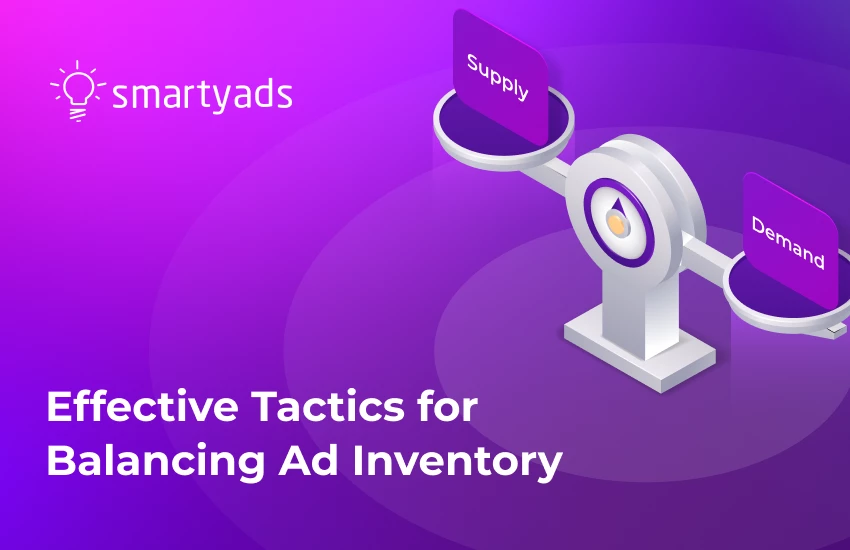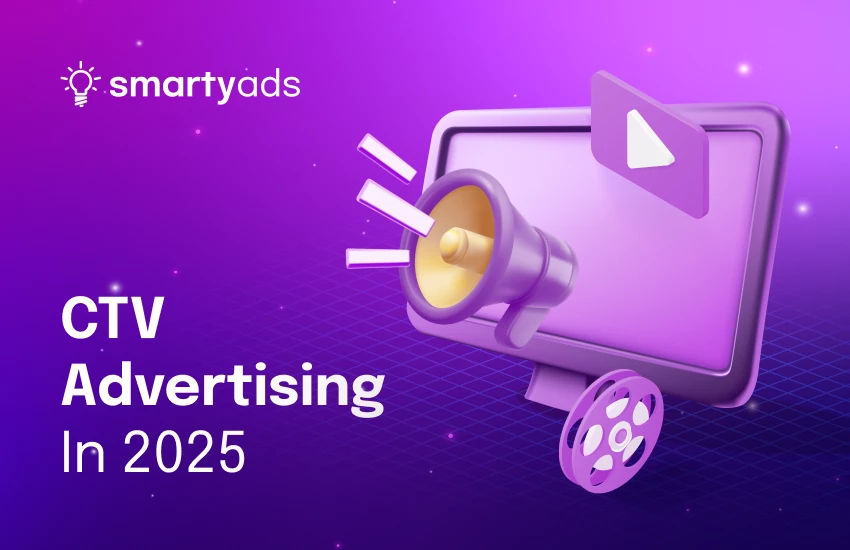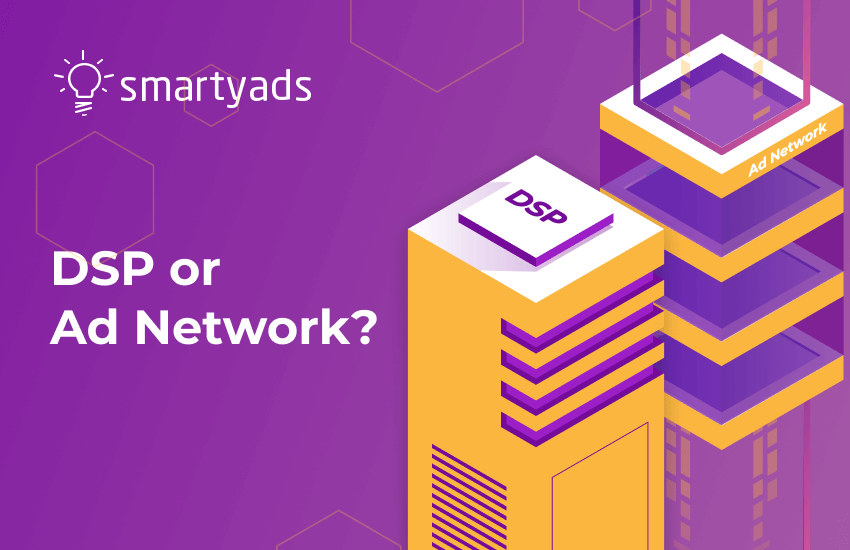The bustling ecosystem of programmatic advertising might be a bit challenging to navigate. If you are a publisher and have some ads inventory to offer to potential advertisers, it’s paramount to know more about finding the right balance between the supply and demand of your ad inventory.
When the balance is disrupted, it might lead to some negative consequences for both parties — either advertisers won’t be able to acquire the desired number of ad impressions for an adequate price, or publishers will lack advertisers searching for quality ad placements and lose revenue. So the natural question arises: How can one achieve this well-sought supply-demand balance when it comes to ad inventory? This is exactly what we are going to cover in this article to take your AdTech game to a whole new level.

What is an ad inventory
Advertising inventory is the total amount of advertising space that a publisher has available for sale. Simply put, it’s the number of ad placements that can be displayed on the publisher’s resource and which advertisers can purchase for their marketing efforts. Ad publishers can sell their digital inventory in multiple formats such as display, video, or native ads across a variety of platforms like desktop and mobile websites, mobile apps, TV, and so on.
Usually, ad inventory can be managed by website or app owners through Supply Side Platforms and distributed to advertisers through DSPs, ad exchange platforms, or online ad networks. Publishers make the decision on how much of their platform’s space to allocate to advertising as well as where to place it.
For instance, a website’s home page is the most high-value ad placement and is defined by site traffic and ad views. This type of advertising inventory is called premium.
There is another type of inventory, remnant or so-called unsold, implying that some of the publisher’s placements couldn’t be sold via programmatic deals. However, this space can also be utilized and offered at a lower cost via ad exchanges.
Understanding ads inventory and its management is crucial for website owners as the more media inventory they have, the more they can sell, thus maximizing the revenue of each digital ad placement. But what if the demand on your ad inventory is bigger than your offer? Or vice versa? Now, let’s explore what you can do to prevent this from happening.
5 tactical approaches to supply-demand harmony in ad inventory
Ad inventory management is critical, but what are the actionable steps you can take to deal with the high-volume demand on your limited inventory?
Here are the effective tactics that will allow you to make the most revenue from your website or application, as well as to maintain the overall balance of your ad supply and demand to mitigate potential risks.
Power of dynamic pricing in ad inventory management
One of the main ways to attain optimal inventory monetization is by adopting a dynamic pricing strategy. What does it mean? The main metric in programmatic advertising is CPM (cost per mille). It measures the price advertisers pay for every 1000 times the ad is displayed to your audience.
There are two types of CPM — fixed and dynamic. Whereas fixed CPM is simple, predictable, and enables stability for both publisher and advertiser, it’s not the best choice when striving for supply-demand balance in your advertising game.
Therefore, the optimal choice is to switch to dynamic CPM, which adjusts in real time based on supply and demand fluctuations. This move will allow you to maximize your revenue and get as much profit as possible without compromising your results.
The advertisers will bid for your stock ad space in real time and only the highest-paying advertiser will win the impression. The process is completely automatic through an SSP and is an efficient way to manage and optimize your advertising space without losing profit. Moreover, you will even be able to benefit from market fluctuations and yield from the most interested advertisers.
The role of AI-Powered predictive analytics in balancing ad inventory
AI has become an indispensable technology used by so many businesses daily. As its main goal is to simplify our day-to-day tasks and reinforce our operational efficiency, predictive analytics come in handy in advertising inventory management.
First of all, AI-powered algorithms can accurately predict future trends in ad demand, which will help you make more informed decisions about your publishing strategies. With detailed insights based on historical data and external market trends, predictive analytics enables website/app owners to optimize their resource allocation as well as their ad space accordingly.
What else do AI and predictive analytics do to balance inventory in marketing and advertising? It effectively tracks performance and precisely analyzes core ad metrics like CPM and revenue generated by ad placements so publishers can detect top-performing placements and optimize the pricing in the future. Read more about performance based advertising and how it is measured.
For instance, if AI indicates that a certain ad placement generates high revenue during a particular season, a publisher can prepare in advance and offer this placement at a premium rate during that specific season to maximize yield.
With the ability to predict the future ad demand volume, inventory management will be easier and more productive, preparing website owners for potential fluctuations without losing advertising opportunities and revenue.
And one extra benefit that makes predictive AI helpful is its ability to detect ad fraud. As it’s a very big concern for both publishers and advertisers, AI can detect fraudulent traffic patterns or user behavior, thus enabling them to take adequate measures to prevent it and offer the best customer experience to advertisers.
Optimizing ad inventory through cross-channel integration strategies
Another key strategy for optimizing your ad inventory is integrating cross-channel efforts. Cross-channel or omni-channel advertising strategy is how advertisers can connect with their audiences beyond mere traditional channels.
From desktop and mobile web to in-app advertising, connected TV, and digital out-of-home (DOOH), advertisers are interested in omnichannel efforts to ensure consistent and cohesive advertising activities across all platforms.
How can it help publishers manage their ad space more effectively? First of all, it’s possible to offer more diverse, targeted, and personalized ad placements and reach advertisers interested in ad placements across multiple touchpoints, creating more monetization opportunities.
This cross-channel strategy enables publishers to optimize their yield management through dynamically adapting ad placements and pricing based on demand and supply data from various sources. It helps achieve better adspace control, therefore enhancing the balance of ad supply and demand.
How collaborative partnerships shape a balanced ad inventory approach
To attain a supply and demand balance in your ad media inventory management, it’s important to consider establishing strategic collaborations between suppliers and advertisers. The approach will lead to an ecosystem with seamlessly aligned supply and demand.
By facilitating transparent communication and data sharing with trusted advertisers, publishers can have more accurate forecasting of inventory demand as well as benefit from it. In their turn, advertisers will gain access to top-performing ad placements tailored to their desired target audience.
By uniting their efforts towards common goals, both publishers and advertisers inside of the AdTech ecosystem can foster a dynamic marketplace where ad space is efficiently utilized, maximizing revenue for all parties involved. In essence, collaborative partnerships form the foundation of a balanced ad inventory approach, driving success and sustainability in the ever-evolving digital advertising landscape.
Adapting to emerging trends in ad formats for supply-demand harmony
We all know how paramount it is to stay ahead of the latest trends and tendencies in the dynamic ad world. The same goes for monitoring and adopting the latest practices in ad formats.
The advertising landscape is constantly evolving, offering more advanced ad format options to users covering their respectively increasing expectations. Staying at the forefront of the ad format shift allows website and app owners to positively impact their supply and demand in advertising marketing inventory.
The year 2024 already brought new ad formats that are reshaping ways advertisers should connect with their future audience. To boost advertisers' engagement and provide them with more up-to-date ways to effectively get in touch with their audience, publishers need to also adopt these new ad formats and adapt their inventory following current tendencies.
The AdTech world has demonstrated an interest in more interactive and dynamic formats of advertisements. This interest can be explained by the need for users to receive more custom and personalized experiences, and older ad formats are getting less effective in drawing user attention.
By enabling support for diverse ad formats on their resources, publishers optimize their media inventory and maximize ad space utilization, thus fostering more demand from advertisers and yielding increased revenue opportunities.
In turn, advertisers increase their chances of being seen by the right audience in the right place. In addition, with the creative autoresize feature, advertisers don’t have to worry about manually adjusting the banner size as it’s done automatically. Therefore, they can reach a broader audience, meet their audience expectations, and respectively generate more value for publishers' ad placements.

Consider SmartyAds your trusted partner
If you want to reinforce your advertising efforts and are searching for a trusted partner in the realm of programmatic advertising, SmartyAds is here to offer you top-notch industry experience and a feature-rich SSP platform.
Monetize and effectively manage your inventory to enable a perfect balance in your supply and demand. Our transparent and safe programmatic ecosystem offers unlimited access to a wide network of demand sources so you can plan your trading strategy using advanced forecasting and close profitable deals with advertisers.
SmartyAds' powerful ad inventory management feature gives you full control over your inventory in real time. You will have a wide range of functionality available, from utilizing selective search, configuring price floors to approving certain demand partners and blacklisting specific ads from being displayed on your website or app.
To streamline your ad inventory management, don’t hesitate to try out SmartyAds SSP available. Monitor, track, and optimize your inventory with ease from a unified feature-rich platform designed for your convenience and success.
Wrapping up
To sum up, effective advertising inventory management is paramount for successful advertising endeavors. In order to monetize your website traffic accordingly, easily navigate industry shifts, and adapt to all the industry fluctuations, mastering core strategies to balance your ad supply and demand is essential.
With the right strategies, leverage our insights to harness the full potential of ad inventory and achieve sustainable business growth. SmartyAds stands ready as your reliable partner, offering a robust and feature-rich SSP platform to make your digital ad success real. Remember to stay agile and adaptive to rapid industry changes to ensure a healthy supply-demand balance and stay ahead in this evolving ecosystem.
Monetize your ad inventory with the highest CPM and skyrocket your success with SmartyAds SSP.





